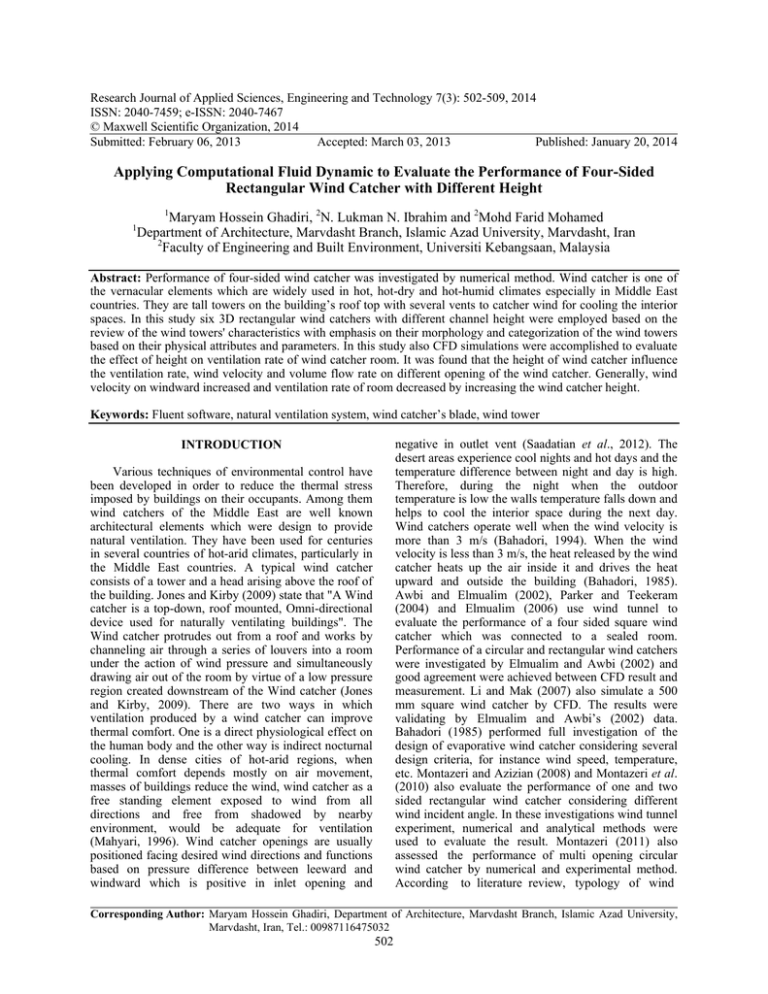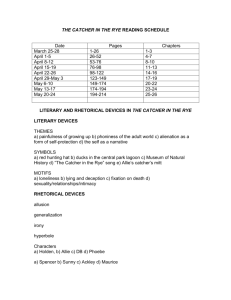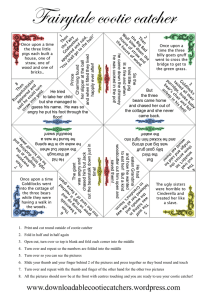Research Journal of Applied Sciences, Engineering and Technology 7(3): 502-509,... ISSN: 2040-7459; e-ISSN: 2040-7467
advertisement

Research Journal of Applied Sciences, Engineering and Technology 7(3): 502-509, 2014 ISSN: 2040-7459; e-ISSN: 2040-7467 © Maxwell Scientific Organization, 2014 Submitted: February 06, 2013 Accepted: March 03, 2013 Published: January 20, 2014 Applying Computational Fluid Dynamic to Evaluate the Performance of Four-Sided Rectangular Wind Catcher with Different Height 1 Maryam Hossein Ghadiri, 2N. Lukman N. Ibrahim and 2Mohd Farid Mohamed Department of Architecture, Marvdasht Branch, Islamic Azad University, Marvdasht, Iran 2 Faculty of Engineering and Built Environment, Universiti Kebangsaan, Malaysia 1 Abstract: Performance of four-sided wind catcher was investigated by numerical method. Wind catcher is one of the vernacular elements which are widely used in hot, hot-dry and hot-humid climates especially in Middle East countries. They are tall towers on the building’s roof top with several vents to catcher wind for cooling the interior spaces. In this study six 3D rectangular wind catchers with different channel height were employed based on the review of the wind towers' characteristics with emphasis on their morphology and categorization of the wind towers based on their physical attributes and parameters. In this study also CFD simulations were accomplished to evaluate the effect of height on ventilation rate of wind catcher room. It was found that the height of wind catcher influence the ventilation rate, wind velocity and volume flow rate on different opening of the wind catcher. Generally, wind velocity on windward increased and ventilation rate of room decreased by increasing the wind catcher height. Keywords: Fluent software, natural ventilation system, wind catcher’s blade, wind tower negative in outlet vent (Saadatian et al., 2012). The desert areas experience cool nights and hot days and the temperature difference between night and day is high. Therefore, during the night when the outdoor temperature is low the walls temperature falls down and helps to cool the interior space during the next day. Wind catchers operate well when the wind velocity is more than 3 m/s (Bahadori, 1994). When the wind velocity is less than 3 m/s, the heat released by the wind catcher heats up the air inside it and drives the heat upward and outside the building (Bahadori, 1985). Awbi and Elmualim (2002), Parker and Teekeram (2004) and Elmualim (2006) use wind tunnel to evaluate the performance of a four sided square wind catcher which was connected to a sealed room. Performance of a circular and rectangular wind catchers were investigated by Elmualim and Awbi (2002) and good agreement were achieved between CFD result and measurement. Li and Mak (2007) also simulate a 500 mm square wind catcher by CFD. The results were validating by Elmualim and Awbi’s (2002) data. Bahadori (1985) performed full investigation of the design of evaporative wind catcher considering several design criteria, for instance wind speed, temperature, etc. Montazeri and Azizian (2008) and Montazeri et al. (2010) also evaluate the performance of one and two sided rectangular wind catcher considering different wind incident angle. In these investigations wind tunnel experiment, numerical and analytical methods were used to evaluate the result. Montazeri (2011) also assessed the performance of multi opening circular wind catcher by numerical and experimental method. According to literature review, typology of wind INTRODUCTION Various techniques of environmental control have been developed in order to reduce the thermal stress imposed by buildings on their occupants. Among them wind catchers of the Middle East are well known architectural elements which were design to provide natural ventilation. They have been used for centuries in several countries of hot-arid climates, particularly in the Middle East countries. A typical wind catcher consists of a tower and a head arising above the roof of the building. Jones and Kirby (2009) state that "A Wind catcher is a top-down, roof mounted, Omni-directional device used for naturally ventilating buildings". The Wind catcher protrudes out from a roof and works by channeling air through a series of louvers into a room under the action of wind pressure and simultaneously drawing air out of the room by virtue of a low pressure region created downstream of the Wind catcher (Jones and Kirby, 2009). There are two ways in which ventilation produced by a wind catcher can improve thermal comfort. One is a direct physiological effect on the human body and the other way is indirect nocturnal cooling. In dense cities of hot-arid regions, when thermal comfort depends mostly on air movement, masses of buildings reduce the wind, wind catcher as a free standing element exposed to wind from all directions and free from shadowed by nearby environment, would be adequate for ventilation (Mahyari, 1996). Wind catcher openings are usually positioned facing desired wind directions and functions based on pressure difference between leeward and windward which is positive in inlet opening and Corresponding Author: Maryam Hossein Ghadiri, Department of Architecture, Marvdasht Branch, Islamic Azad University, Marvdasht, Iran, Tel.: 00987116475032 502 Res. J. Appl. Sci. Eng. Technol., 7(3): 502-509, 2014 Fig. 1: Categorization of wind catchers (Mahmoudi and Mofidi Shemirani, 2009) Fig. 2: Location of 52 selected wind catcher in Yazd city catchers are neglected and simple geometry plan of wind catcher is selected for performance evaluation. In this study wind catchers are categorized based on different attributes to come up with common form of wind catchers for simulation. Among few authors who do some research on wind catchers morphology, Roaf (1982) conducted a comprehensive study on wind catchers in the city of Yazd, Iran, to record every wind catcher. The study has provided a detailed picture of the types, distribution and history of wind catcher in this city, as well as the impact of the wind catcher on the internal climate of traditional houses. According to Roaf’s survey, wind catchers are found in eastern countries such as Iraq, Afghanistan, Pakistan and Iran but they come in variety of cross sections and forms in Iran (Fig. 1) such as circle, Octagon, polygon, square and rectangle. However, no triangular form has been existed in the Middle East. Wind catcher with a circular plan or form is very rare and such type of wind catcher does not exist in common houses. One, two and four directional wind towers usually have rectangular plan whereas the square form is the type used in the four directional wind towers. Eight directional wind towers are those with an octagonal plan. 52 out of 713 recorded wind catchers by Roaf were chosen in different region of central Yazd in Iran which is marked by gray points in Fig. 2 to achieve a common 503 Res. J. Appl. Sci. Eng. Technol., 7(3): 502-509, 2014 Table 1: Wind catcher type Wind catcher type One directional towers Two directional towers Towers with diagonal partitions Four directional towers Six or eight sides towers Percentage 3% 18% 16% 60.2% 2.8% Building type Water cistern Ordinary house Ordinary house Ordinary house Water cistern model wind catcher for simulation. In line with Roaf (Beazley et al., 1982) survey, wind catchers are categorized in five main types represented in Table 1. CFD SIMULATION MODEL The simulations were consisted of 6 rectangular wind catchers’ models with different height and same blades geometry (internal portions which divide wind catcher into several parts). Wind catcher with plus blade shape and rectangular plan form is the most frequent wind catcher among 52 investigated wind catchers. The objective of this study was to explore the effect of height on volume flow rate and air velocity on different opening of wind catcher and finally represent a rule of thumb for this type of wind catcher. The height of the simulated wind catchers were set at 4.5 m, 6.5 m, 8.5 m, 10.5 m, 14.5 m and 18.5 according to the height range of the Yazd rectangular wind catcher (Table 2). The shelf height (opening of the wind catcher in windward and leeward side) was fixed at 2 m based on statistic analyze of Yazd wind catchers represented in Table 3. The dimension of length and width of wind catcher plan with the ratio of 1.5 were set at 2.25 m and 1.5 m respectively (Table 4 to 6). Through Fig. 3 the ratio between width and length of the room connected to wind catcher varies in Yazd’s houses including 1:1, 1:1.2, 1:1.3 and 1:1.5 (Mahmoudi and Mofidi, 2011). The ratio of 1 to 1.5 was chosen as a large module for the simulation. Prevailing wind blow from North-West to south east in Yazd so Yazd’s wind catchers are placed in North-West direction and room’s windows are positioned on the opposite side of the wind catcher wall. Therefore the attached room to the wind catcher model had a 0.7m by 1.5m window in South-East elevation. To validate the CFD results, Mahyari’s (1996) experimental results were used. The study was accomplished in a boundary layer wind tunnel using a model of typical courtyard house equipped with a number of wind catchers. In Mahyari’s experiment, a “plus” shape rectangular base design of a wind catcher attached to a model of a house was examined. To determine velocity and velocity coefficient in each individual shaft, four probes of anemometers, depending upon the numbers of the shafts, were used in the centre of each shaft vertically. For the purpose of comparison, the air velocity value from CFD simulation changes to velocity coefficient. The velocity coefficient which is a dimensionless value is defined as the ratio of the value of velocity at the point of interest to the value at the reference height presented in Eq. (1): Table 2: Wind catcher height Wind catcher height (cm) < = 500 501-800 801-1100 1101-1400 1401-1700 >1700 Frequency 1 9 28 9 2 3 Percentage 2% 17.6% 53% 17.6% 3.9% 5.9% Table 3: Wind catcher’s shelf height Wind catcher shelf height(cm) Frequency 50-150 5 151-250 25 251-350 12 351-450 7 451-550 1 551-650 1 Percentage 9.8% 49% 23.5% 13.7% 2% 2% Table 4: Wind catcher plan width Windcatcher plawidth(cm) <=100 101-200 201-300 >300 Frequency 8 35 8 1 Percentage 13.7% 68.6% 15.7% 2% Table 5: Wind catcher plan length Wind catcher length(cm) <= 200 201-300 301-400 401-500 >500 Frequency 11 23 13 2 2 Percentage 21.6% 45.1% 25.5% 3.9% 3.9% Table 6: Wind catcher plan ratio Wind catcher plan ratio <=1.00 1.01-1.50 1.51-2.00 2.01-2.50 2.51-3.00 3.51-4.00 Frequency 3 18 17 11 1 1 Percentage 5.9 35.3 33.3 21.6 2.0 2.0 Fig. 3: Wind catcher room dimension in Yazd house 𝑉𝑉 𝐶𝐶𝑣𝑣𝑣𝑣 = 𝑖𝑖�𝑉𝑉 𝑟𝑟𝑟𝑟𝑟𝑟 504 (1) where, 𝑉𝑉𝑖𝑖 : The mean or peak wind speed at the point of interest 𝑉𝑉𝑟𝑟𝑟𝑟𝑟𝑟 : The mean or peak wind speed at the reference height Res. J. Appl. Sci. Eng. Technol., 7(3): 502-509, 2014 MATHEMATICAL MODEL SETUP OF CFD SIMULATIONS Mesh design, boundary conditions and convergence criteria: Three different turbulence models were investigated including k-ɛ, RNG k-ɛ and RSM. To investigate the solution independency from the grid, four different meshes were generated which is shown in Table 7. Grid B was chosen due to low rate of error compared to experimental data accomplished by Mahyari (1996). In order to reduce the bulk of simulations, half geometry with a symmetry plane was used. The total number of grid in simulations was approximately 1840000 to 3740000. Structured Hexahedral mesh which had stretched to the wind catcher edges was used for the models (Fig. 6). The velocity inlet boundary condition was assumed for the entrance air and the pressure outlet for the exit air (Fig. 7). In the CFD simulation, the flow profiles of mean wind speed and turbulence quantities that were applied at the inlet plane of the computational domain were generally fully developed, equilibrium profiles. This is expressed by the presence of either the appropriate Geometrical model: In Fig. 4 a three dimensional rectangular wind catcher model of dimension 1.5 m by 2.25 m with same plan geometry of plus blade and different height of 4.5 m, 6.5 m, 8.5 m, 10.5 m, 14.5 m and 18.5 m connected to a room with the length of 6 m an width of 4 m. The wind speed was set at 5 m/s with angle of 0 degree and outdoor temperature was 310 Kelvin degrees which is the average temperature of Yazd during hot days in summer. The geometry of these models were generated by Gambit 2.4 software and simulated with Fluent 6.3. The dimension of the domain was 10 times of wind catcher height for downstream and 5times of wind catcher height for upstream and lateral of the domain based on recommended guidelines in CFD (Casey and Wintergerste, 2000; Franke et al., 2004; Tominaga et al., 2008) and also the height above the wind catcher was set at 5 times of the wind catcher height represented in Fig. 5. Fig. 4: Simulated wind catcher dimension. All dimensions are in millimeter Fig. 5: Domain dimension of wind catcher 505 Res. J. Appl. Sci. Eng. Technol., 7(3): 502-509, 2014 Table 7: Grid sensitivity study Grid name Grid A Grid B Grid C of the inlet profiles. The vertical velocity profile U (z) on flat terrain is usually given by a power law, expressed in Eq. (2): Number of grid 2760000 1840000 1226000 𝑈𝑈2 / 𝑈𝑈1 = (z2 /z1 )α (2) where U 2 and U 1 are the mean wind velocity at heights z 2 and z 1 , respectively and α is the power law index with the value of 0.4 for suburban area based on the terrain category represented in Table 8. A terminate criterion of five order of magnitude were used to have a convergence which is recommended by Tominaga et al. (2008) and Franke et al. (2004). In addition to the residuals, monitoring positions was defined in the region of interest and the solution was regarded converged when interested variables were constant (Casey and Wintergerste, 2000). Wind velocity in entrance vent of wind catcher and mass flow rate of different aperture of wind catcher are calculated by fluent software as a numerical simulator. Fig. 6: Plan and side elevation of wind catcher geometry with hexahedral structural mesh aerodynamic roughness length y 0 or the appropriate power-law exponent α of the terrain in the expressions Fig. 7: Boundary condition in Fluent Table 8: Terrain surface roughness z° Roughness class Roughness length (m) 0 0.002 0.5 0.0024 1 0.03 1.5 0.055 2 0.1 2.5 0.2 3 0.4 3.5 4 0.8 1.6 Landscape type Water surface Completely open terrain with a smooth surface Open agricultural area without fences and hedgerows and very scattered buildings. Agricultural land with some houses and 8-m tall sheltering hedgerows at the distance of approximately 1250 m. Agricultural land with some houses and 8-m tall sheltering hedgerows at the distance of approximately 500 m. Agricultural land with many houses, shrubs, and plants, or 8-m tall sheltering hedgerows at the distance of approximately 250 m. Village, small towns, and agricultural land with many tall sheltering hedgerows, forests, and very rough and uneven terrain. Large cities with tall buildings Very large cities with tall buildings and skyscrapers. 506 Res. J. Appl. Sci. Eng. Technol., 7(3): 502-509, 2014 RESULTS AND DISCUSSION Table 9 shows a comparison between the measured and calculated velocity coefficient through windward and leeward of the wind catcher (Fig. 8) for various turbulence models at air incident angle of 0º. In general it shows that good agreement has been achieved. The result of calculated velocity coefficient show relatively little variation for the RSM and RNG k-ɛ turbulence models compare to the experimental data accomplished by Mahyari (1996). Therefore in this study k-ɛ turbulence model was used for all simulations. In Fig. 9, air velocity decreased in windward and increased in leeward when wind contacts the wind catcher’s facade. When air meets the non-aerodynamic Fig.8: Reference points of wind catcher model (A, B, C and D are the surface of right leeward, front leeward, windward and left leeward respectively) Fig. 9: X-Velocity contour in wind catcher with height of a) 4.5 m, b) 6.5 m, c) 8.5, d) 10.5, e) 14.5 and f) 18.5 507 Res. J. Appl. Sci. Eng. Technol., 7(3): 502-509, 2014 angle of 0º in CFD and Leeward (A) -0.39 Leeward (D) -0.39 -0.46 -0.44 -0.48 -0.46 -0.44 -0.48 Wind velocity on windward (m/s) Table 9: Comparison of velocity coefficient for wind wind tunnel experiment Windward Leeward Case (C) (B) Experimental +0.97 -0.55 wind tunnel RSM +1.09 -0.56 +1.01 -0.55 k-ɛ -0.54 RNG k-ɛ +1.07 CFD Table 10: CFD result Wind velocity on windward (m/s) Reference point Air velocity on C Mass flow rate on C Mass flow rate on duct Mass flow rate on A Mass flow rate on B Volume flow rate on duct 2.5 Wind catcher height ----------------------------------------------------------4.5 6.5 8.5 10.5 14.5 18.5 1.54 1.69 1.73 1.77 1.82 1.96 -4 -4.36 -4.5 -4.58 -4.66 -4.68 1.76 1.38 1.28 1.24 1.2 1.18 1.8 3.28 3.74 3.52 2.92 2.92 0.5 -0.04 -0.44 0.04 0.48 0.58 1.54 1.2 1.12 1.08 1.04 1.02 Polinomial mass flow rate 1.6 1.4 1.2 1.0 0.8 2 Y = 0.0346x -0.3091x+1.772 2 R = 0.9372 0.6 0.4 0.2 0.0 4.5 6.5 10.5 14.5 8.5 Wind catcher height (m) 18.5 Fig. 12: Volume flow rate on duct of the wind catcher with different height Wind velocity on windward catcher height increased. The linear correlation between windward velocity and wind catcher height can be represented in Eq. (3) whereas 𝑉𝑉𝑊𝑊 is the air velocity on windward and H is the height of the wind catcher: Linear velocity 2.0 1.5 Y = 0.0723x+1.4987 2 R = 0.938 1.0 0.5 4.5 6.5 10.5 14.5 8.5 Wind catcher height (m) 18.5 Fig. 10: Wind velocity on windward of the wind catcher with different height Polynomial mass flow rate -4.6 -4.4 -4.2 Y = 0.0346x 2-0.3676x-3.702 2 R = 0.9783 -4.0 -3.8 -3.6 4.5 6.5 10.5 14.5 8.5 Wind catcher height (m) (3) 𝑚𝑚𝑊𝑊 = 0.0346𝐻𝐻 2 -0.3676 𝐻𝐻-3.702 (4) Q = 0.0314 𝐻𝐻 2 -0.3091 𝐻𝐻+1.772 (5) Wind speed up through wind catcher channel and it passed through duct in higher velocity by enhancing the wind catcher height. The partitions within the tower of traditional wind catchers which creates separate shafts toward different directions are considered to take advantage of wind from all directions. Besides, this experiment indicates that this multi directionally channel can cause 50% to 80% of incoming air to be lost through the leeward shafts as a disadvantage. Therefore, because great portion of incoming air leaves the channels before entering the room, the mass flow rate of air decreased in duct. On the other hand, fresh air enters the room via a part of the duct and exit from the room via other part of it after circulating through the room, so there are two velocity vectors in two different direction which cause air velocity and mass flow rate to be decreased and by increasing the height of the channel, the pressure difference between leeward and windward increased causing more air escape from leeward. Volume flow rate of the air leaving the tower and entered the room (duct) is represented in Eq. (5) whereas Q is the volume flow rate and H is the wind catcher height (Fig. 12). Mass flow rate on windward -4.8 𝑉𝑉𝑊𝑊 = 0.0723 H+1.4987 The polynomial correlation between windward mass flow rate and wind catcher height can be represented in Eq. (4) whereas 𝑚𝑚𝑊𝑊 is the mass flow rate on windward and H is the height of the wind catcher: 0 Wind velocity on windward (m/s) Volume flow rate on duct 1.8 18.5 Fig. 11: Mass flow rate on windward of the wind catcher with different height substances, wake which is an area with high pressure and low velocity constituted due to the separation. We had a turbulence stream in wake area where fluid usually turbulent and cross air value decreased which caused higher air velocity on leeward. Hence, the wind entered the channel with lower air velocity which was around 2m/s depends on the wind catcher height. Table 10 presents mass flow rate and air velocity in different point of wind catcher shown in Fig. 8. In Fig. 10 and 11, Wind velocity and mass flow rate on windward is increased steadily while wind 508 Res. J. Appl. Sci. Eng. Technol., 7(3): 502-509, 2014 CONCLUSION Jones, B.M. and R. Kirby, 2009. Quantifying the performance of a top-down natural ventilation Windcatcher (TM). Build. Environ., 44(9): 1925-1934. Li, L. and C. Mak, 2007. The assessment of the performance of a windcatcher system using computational fluid dynamics. Build. Environ., 42(3): 1135-1141. Mahmoudi, M. and S.M. Mofidi, 2011. Investigation of architecture of wind tower's plan on the environmental temperature reduction. J. Environ. Sci. Technol., 13(1 (48): 83-91. Mahyari, A., 1996. The wind catcher: A passive cooling device for hot arid climate. Ph.D. Thesis, Universityof Syndey, Syndey. Montazeri, H., 2011. Experimental and numerical study on natural ventilation performance of various multi-opening wind catchers. Build. Environ., 46(2): 370-378. Montazeri, H. and R. Azizian, 2008. Experimental study on natural ventilation performance of onesided wind catcher. Build. Environ., 43(12): 2193-2202. Montazeri, H., F. Montazeri, R. Azizian and S. Mostafavi, 2010. Two-sided wind catcher performance evaluation using experimental, numerical and analytical modeling. Renew. Energ., 35(7): 1424-1435. Parker, J. and A. Teekeram, 2004. Design and Application Guide for Roof Mounted Natural Ventilation Systems. BSRIA, UK. Roaf, S., 1982. Wind Catchers. In: Beazley, E. (Ed.), Living With the Desert. Air and Philips, England. Saadatian, O., L.C. Haw, K. Sopian and M.Y. Sulaiman, 2012. Review of windcatcher technologies. Renew. Sustain. Energ. Rev., 16(3): 1477-1495. Tominaga, Y., A. Mochida, R. Yoshie, H. Kataoka, T. Nozu, M. Yoshikawa and T. Shirasawa, 2008. AIJ guidelines for practical applications of CFD to pedestrian wind environment around buildings. J. Wind Eng. Ind. Aerodyn., 96(10): 1749-1761. Computational Fluid Dynamic (CFD) modeling were conducted to investigate ventilation performance of four- sided rectangular wind catcher with different channel height ranging from 4.5 m to 18.5 m to find out the effect of changing height on ventilation rate of the wind catcher connected to a room with an openble window at the back of it. To achieve this particular aim six rectangular model with same cross section were employed. For all these six shapes, the ventilated air flow rate into the test room was measured. Generally wind velocity on windward increased and ventilation rate decreased by increasing the wind catcher height. REFERENCES Awbi, H. and A. Elmualim, 2002. Full scale model Windcatcher performance evaluation using a wind tunnel. Proceedings of the World Renewable Energy Congress VII, Elsvier Science Ltd., Cologne, Germany. Bahadori, M.N., 1985. An improved design of wind towers for natural ventilation and passive cooling. Solar Energ., 35(2): 119-129. Bahadori, M.N., 1994. Viability of wind towers in achieving summer comfort in the hot arid regions of the Middle East. Renew. Energ., 5(5-8): 879892. Beazley, E., M. Harverson, et al., 1982. Living with the Desert: Working buildings of the Iranian Plateau. Aris and Phillips, Warminster, Wilts, England. Casey, M. and T. Wintergerste, 2000. Best Practices Guidelines. ERCOFTAC Special Interest Group on Quality and Trust in Industrial CFD, ERCOFTAC, Brussels. Elmualim, A.A., 2006. Dynamic modelling of a wind catcher/tower turret for natural ventilation. Build. Serv. Eng. Res. Technol., 27(3): 165-182. Elmualim, A.A. and H.B. Awbi, 2002. Wind tunnel and CFD investigation of the performance of wind catcher ventilation systems. Int. J. Ventilat., 1(1): 53-64. Franke, J., C. Hirsch, A.G. Jensen, H.W. Krüs, M. Schatzmann, P.S. Westbury, S.D. Miles, J.A. Wisse and N.G. Wright, 2004. Recommendations on the use of CFD in wind engineering. Proceedings of the International Conference on Urban Wind Engineering and Building Aerodynamics, COST Action C14, Impact of Wind and Storm on City Life Built Environment Von Karman Institute, Sint-Genesius-Rode Belgium. 509






